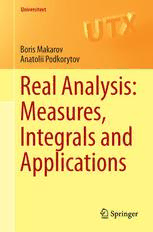
Real Analysis: Measures, Integrals and Applications PDF
Preview Real Analysis: Measures, Integrals and Applications
Universitext Universitext SeriesEditors: SheldonAxler SanFranciscoStateUniversity,SanFrancisco,CA,USA VincenzoCapasso UniversitàdegliStudidiMilano,Milan,Italy CarlesCasacuberta UniversitatdeBarcelona,Barcelona,Spain AngusMacIntyre QueenMary,UniversityofLondon,London,UK KennethRibet UniversityofCalifornia,Berkeley,Berkeley,CA,USA ClaudeSabbah CNRS,ÉcolePolytechnique,Palaiseau,France EndreSüli UniversityofOxford,Oxford,UK WojborA.Woyczynski CaseWesternReserveUniversity,Cleveland,OH,USA Universitext is a series of textbooks that presents material from a wide variety of mathematical disciplines at master’s level and beyond. The books, often well class-tested by their author, may have an informal, personal, even experimental approach to their subject matter. Some of the most successful and established books in the series have evolved through several editions, always following the evolutionofteachingcurricula,intoverypolishedtexts. Thus as research topics trickle down into graduate-level teaching, first textbooks writtenfornew,cutting-edgecoursesmaymaketheirwayintoUniversitext. Forfurthervolumes: www.springer.com/series/223 Boris Makarov (cid:2) Anatolii Podkorytov Real Analysis: Measures, Integrals and Applications BorisMakarov AnatoliiPodkorytov MathematicsandMechanicsFaculty MathematicsandMechanicsFaculty StPetersburgStateUniversity StPetersburgStateUniversity StPetersburg,Russia StPetersburg,Russia TranslatedfromtheRussianlanguageedition: Lekcii po vewestvennomu analizu byB.M. Makarov, A.N. Podkorytov(B.M.Makarov,A.N.Podkorytov) Copyright©BHV-Peterburg(BHV-Petersburg)2011 Allrightsreserved. ISSN0172-5939 ISSN2191-6675(electronic) Universitext ISBN978-1-4471-5121-0 ISBN978-1-4471-5122-7(eBook) DOI10.1007/978-1-4471-5122-7 SpringerLondonHeidelbergNewYorkDordrecht LibraryofCongressControlNumber:2013940613 Mathematics Subject Classification: 28A12, 28A20, 28A25, 28A35, 28A75, 28A78, 28B05, 31B05, 42A20,42B05,42B10 ©Springer-VerlagLondon2013 Thisworkissubjecttocopyright.AllrightsarereservedbythePublisher,whetherthewholeorpartof thematerialisconcerned,specificallytherightsoftranslation,reprinting,reuseofillustrations,recitation, broadcasting,reproductiononmicrofilmsorinanyotherphysicalway,andtransmissionorinformation storageandretrieval,electronicadaptation,computersoftware,orbysimilarordissimilarmethodology nowknownorhereafterdeveloped.Exemptedfromthislegalreservationarebriefexcerptsinconnection with reviews or scholarly analysis or material supplied specifically for the purpose of being entered and executed on a computer system, for exclusive use by the purchaser of the work. Duplication of this publication or parts thereof is permitted only under the provisions of the Copyright Law of the Publisher’slocation,initscurrentversion,andpermissionforusemustalwaysbeobtainedfromSpringer. PermissionsforusemaybeobtainedthroughRightsLinkattheCopyrightClearanceCenter.Violations areliabletoprosecutionundertherespectiveCopyrightLaw. Theuseofgeneraldescriptivenames,registerednames,trademarks,servicemarks,etc.inthispublication doesnotimply,evenintheabsenceofaspecificstatement,thatsuchnamesareexemptfromtherelevant protectivelawsandregulationsandthereforefreeforgeneraluse. Whiletheadviceandinformationinthisbookarebelievedtobetrueandaccurateatthedateofpub- lication,neithertheauthorsnortheeditorsnorthepublishercanacceptanylegalresponsibilityforany errorsoromissionsthatmaybemade.Thepublishermakesnowarranty,expressorimplied,withrespect tothematerialcontainedherein. Printedonacid-freepaper SpringerispartofSpringerScience+BusinessMedia(www.springer.com) Diagram of Chapter Dependency v Preface to the English Translation This book reflects our experience in teaching at the Department of Mathematics and Mechanics of St. Petersburg State University. It is aimed primarily at readers makingtheirfirstacquaintancewiththesubject. Lecturecoursesonmeasuretheoryandintegrationareoftenconfinedtoabstract measuretheory,withlittleattentionpaid tosuch topicsas integrationwith respect to Lebesgue measure, its transformation under a diffeomorphism and so on—that is, topics that are more special but no less important for applications. Believing thatsuchreticenceiscounterproductive,wechooseanapproachthatavoidsitand combinesgeneralnotionswithclassicalspecialcases. A substantial part of the book is devoted to examples illustrating the obtained resultsbothinandbeyondtheframeworkofmathematicalanalysis,inparticular,in geometry.Theexercisesappearingattheendofalmosteverysectionservethesame purpose. IntheEnglishtranslationweusethree-digitnumbersforsections.Thefirstdigit refers to a Chapter, the second to a Section within the Chapter and the third to Subsection. When referencing to a statement we give the number of a Subsection whichcontainsit.E.g.,Lemma7.5.4wouldmeanalemmafromSect.7.5.4. ComparingwithRussianedition,wehaveextendedthebookbyadding,inpar- ticular,thenewSects.6.1.3and6.2.6. Taking into account the difference between curricula in Russia and the West, as well as the considerable volume of our book, we think it necessary to say sev- eral words about how to use it, and we draw the reader’s attention to the chapter dependencychart.Areaderinterestedonlyinanintroductiontothefoundationsof measuretheoryandintegrationmayprefertoreadonlythosesectionsofChaps.1–5 thatarenotmarkedwitha(cid:2).Thissymbolindicatessectionsthatcontaineithersome illustrativematerial(e.g.,Sects.2.8,6.6–6.7,7.2–7.3,8.7,10.2,10.6),orsomeop- tional information that can be omitted in the first reading (e.g., Sects. 1.6, 4.11, 5.5–5.6, 6.5, 7.4, 8.8, 10.4, 12.1–12.3), or else material used outside Chaps. 1–5 (Sects.2.6,3.4,4.9).ThematerialofSects.1.1–1.4,2.1–2.5,3.1–3.2,4.1–4.8,5.1– 5.4canbetakenasabasisforatwosemestercourseonthefoundationsofmeasure vii viii PrefacetotheEnglishTranslation theory and integration. Time permitting, the course can be extended by including thematerialofSects.6.1–6.2,3.3,4.9,6.4. Thebookcanalsobeusedforcoursesaimedatstudentsfamiliarwiththenotion ofintegrationwithrespecttoameasure.Thereisasufficientlywidechoiceofsuch coursesdevotedtorelativelynarrowtopicsofrealanalysis.Forexample: • Themaximalfunctionanddifferentiationofmeasures(Sects.2.7,4.9,11.2,11.3). • Surfaceintegrals(Sects.2.6,8.1–8.6). • Functionalsinspacesofmeasurableandcontinuousfunctions(Sects.11.1–11.2, Chap.12). • Approximateidentitiesandtheirapplications(Sects.7.5–7.6,Chap.9). • FourierseriesandtheFouriertransform(Chaps.9,10). • A course covering only the preliminaries of the theory of Fourier series and theFouriertransformmaybebased,forexample,onSects.9.1.1–9.1.3,10.1.1– 10.1.4,10.3.1–10.3.6,10.5.1–10.5.4. Acknowledgments We are deeply indebted to Springer for publishing our book andwearehappytoseeitreachamuchwideraudienceviaitsEnglishtranslation. WearegratefultoV.P.Havinwhoattractedthepublisher’sattentiontotheRussian editionofourbooksoonafteritspublication. In the process of preparing and publishing the volume, we have been helped by several people to whom we would like to express our thanks. In particular, the anonymous referees provided us with constructive comments and suggestions. B.M.Bekker,A.A.Lodkin,F.L.NazarovandN.V.Tsilevichundertookthehardtask oftranslation.WewerealsomostfortunatetoreceivefeedbackfromA.I.Nazarov, F.L. Nazarov and O.L. Vinogradov, which helped us to improve the text in many places. Our special thanks go to Joerg Sixt, the Springer Editor, for his invaluable helpandencouragementinpreparingthismanuscript. Wealsowishtoacknowledgethehelpandsupportwereceivedfromourfriends, families and colleagues who read and commented upon various drafts and con- tributedtothetranslation. Our special thanks go to O.B. Makarova (who happened to be a granddaugh- ter of the first of co-authors) who very competently and patiently conducted our correspondencerelatedtopublicationofthisbookandhelpedusenormouslywith proofreading. The translation was carried out with the support of the St. Petersburg State University program “Function theory, operator theory and their applications” 6.38.78.2011. StPetersburg,Russia BorisMakarov AnatoliiPodkorytov Preface Measure theory has been an integral part of undergraduate and graduate curricula in mathematics for a long time now. A number of texts in this subject area have becomewell-establishedandwidelyused.Forexample,onemightrecallbooksby B.Z.Vulih[Vu],A.N.KolmogorovandS.V.Fomin[KF],nottomentiontheclassi- calmonographbyP.Halmos[H].However,booksonmeasuretheorytypicallytreat itasanisolatedsubject,whichmakesitdifficulttoincludeitinageneralcoursein analysisinanaturalandseamlessway.Forexample,theinvarianceoftheLebesgue measureiseitheromittedentirely,orconsideredasaspecialcaseoftheinvariance oftheHaarmeasure.Quiteoften,thequestionofhowLebesguemeasuretransforms underdiffeomorphismsisleftout.Ontheotherhand,mostintroductorycourseson integrationarestillbasedonthetheoryoftheRiemannintegral.Asaresult,thestu- dentsareforcedtoabsorbnumerous,howeversimilar,definitionsbasedonRiemann sumscorrespondingtovarioussituations,suchasdoubleintegrals,tripleintegrals, line integrals, surface integrals and so on. They must also overcome the unneces- sarytechnicalcomplicationscausedbythelackofasufficientlygeneralapproach. Typical examples of such difficulties include justifying the change of the order of integrationandtakinglimitsundertheintegralsign. Forthisreason,oneoftenfacesatwo-tierexpositionofthetheoryofintegration, where at the first stage the notion of measure is not discussed at all, and later the elementary topics are never revisited, leaving the task of reconciling the various approachestothestudent.Theauthorsaimtoeliminatethisdivideandprovidean exposition of the theory of the integral that is modern, yet easily integrated into a generalcourseinanalysis.Thisencapsulatesinatextbooktheestablishedpracticeat theDepartmentofMathematicsandMechanicsoftheUniversityofSt.Petersburg. Thispracticeisbasedonanideaintroducedintheearly60sbyG.P.Akilovandfirst implementedbyV.P.Havinduringtheacademicyear1963–1964. The main emphasis of the book is on the exposition of the properties of the Lebesgueintegralanditsvariousapplications.Thisapproachdeterminedthestyle ofexpositionaswellasthechoiceofthematerial.Itisourhopethatthereaderwho mastersthefirstthirdofthebookwillbesufficientlypreparedtostudyanyareaof ix x Preface mathematicsthatreliesuponthegeneraltheoryofmeasure,suchas,amongothers, probabilitytheory,functionalanalysisandmathematicalphysics. Applicationsofthetheoryofintegrationconstituteasubstantialpartofthisbook. In addition to some elements of harmonic analysis, they also include geometric applications, among which the reader will find both classical inequalities, such as theBrunn–Minkowskiandisoperimetricinequalities,andmorerecentresults,such astheproofofBrouwer’stheoremonvectorfieldsonthespherebasedonachange ofvariables,theK.Ballinequalityandothers.Inordertoillustratetheeffectiveness and applicability of the theorems presented, and to give the reader an opportunity toabsorbthematerialinahands-onfashion,thebookincludesnumerousexamples andexercisesofvariousdegreesofdifficulty. Pedagogicalconsiderationscausedustorefrainfromstatingsomeoftheresults in their full generality. In such cases, references to the appropriate literature are provided for the interested reader. The notion of surface area is discussed in more detailthaniscommoninanalysistexts.Usingadescriptivedefinition,weproveits uniquenessonBorelsubsetsofsmoothandLipschitzmanifolds. Itisdesirablethatthereaderbefamiliarwiththenotionofanintegralofacon- tinuousfunctionofonevariableonanintervalpriortobeingexposedtothebasics ofmeasuretheory.However,wedonotfeelthatthisprerequisitenecessarilyneeds tobefulfilledinthecontextoftheRiemannintegral,whichweviewtobeprimarily ofhistoricalinterest.ApossiblealternativeapproachisoutlinedinAppendix13.1. This book is based on a series of lectures delivered by the authors at the De- partment of Mathematics and Mechanics of St. Petersburg State University. The majorityofthematerialinChaps.1–8approximatelycorrespondstothefourthand fifthsemesteranalysisprogramformathematicsmajorsinourdepartment.Thema- terialfromChaps.9–12andsomeotherpartsofthebookwaspreviouslyincluded bytheauthorsinadvancedcoursesandlecturesinfunctionalanalysis.Someaddi- tionalinformationispresentedinAppendices13.2–13.6.Appendix13.7,dedicated tosmoothmappings,isincludedforthesakeofcompleteness. Thereaderisexpectedtohavethenecessarymathematicalbackground.Thestu- dentsenteringthefourthsemesterattheDepartmentofMathematicsandMechanics ofSt.PetersburgStateUniversityarefamiliarwithmultivariablecalculusandbasic linear algebra. This prerequisite material is used throughout the book without any additionalexplanations.InChap.8,familiaritywiththebasicsofsmoothmanifold theory is assumed. In Appendices 13.2 and 13.3, the rudiments of the theory of metricspacesaretakenforgranted. The authors have previously encountered texts where a definition or notation, once introduced, is never repeated and is used without any further comments or references many pages later. We believe that such manner of presentation, possi- blyappropriateinmonographsofanencyclopedicnature,putstoomuchstrainon the reader’s memory and attention span. Taking into account the fact that this is a textbook intended for relatively inexperienced readers, many of whom will be en- counteringthesubjectmatterforthefirsttime,theauthorsfinditusefultoinclude somerepetitionsandreminders.However,theyareunabletomeasurethedegreeto whichtheyhavesucceededinthisdirection.
